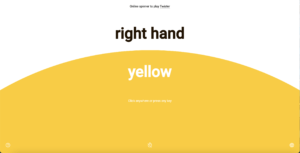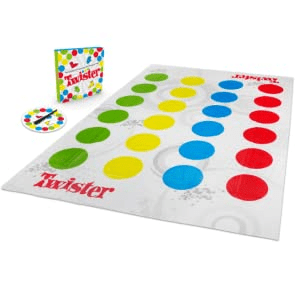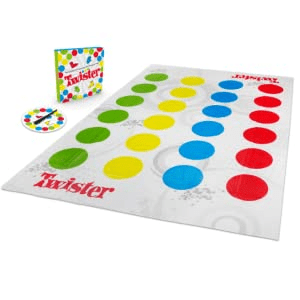For this critical play, I chose to play a game of Twister with my team. Twister is currently produced by Milton Bradley Company and Winning Moves Games USA, but because we didn’t have a copy of the game here, we DIY-ed the board using paper cutouts to imitate the mat and using the following online spinner available at twister-roulette.com:



Twister is a physical, movement-based game that has inspired our own, which we have been advertising as “Twister, but with Truth or Dare.” The premise of Twister is straightforward: each turn, a referee calls out a result from the spinner, and each player must move their corresponding hand/foot to a circle of the corresponding color (based on the spinner result). Players play until they fall (or touch the mat with an elbow or foot), in which case they are eliminated, and the last player “standing” wins.
Twister is a unique and distinctive game: its mechanics require learning only learning very simple instructions, and its simple premise is immediately familiar for anyone who is even minimally engaged with American pop culture. It makes a great party game because it sets up funny scenarios (falling, trying to push others off the mat, etc.) without requiring complex strategy. It also facilitates immediate familiarity between players on the mat. A small and perhaps limiting detail about Twister, however, is that the size of the mat only allows for 2-4 players, and, when playing with 4 players, players must split into teams that “share” responsibility for carrying out the demands of the spinner, because the mat isn’t big enough for everyone to touch every necessary circle.

Idid one playtest of this game with my teammates and close friend. While I knew each person playing quite well, some of the other players were meeting each other for the first time, and those just meeting were a little uncomfortable coming into close contact with each other/trying to push each other off the board. I noticed, however, that comfort amongst the group grew as gameplay progressed. With four players, the mat was definitely cramped, even when playing in teams. I suspect that it was originally designed more-so for children than for four fully-grown adults. Furthermore, we felt satisfied with the game after just two rounds of playing: it began to feel repetitive, and there were only so many ways we could engage with the mat when touching it with just our hands and feet. However, I did think the mat did a great job of maintaining a “magic circle.”
It is also worth noting that the format of Twister can easily be abused to make those who don’t enjoy physical touch extremely uncomfortable. There are no clear rules about how close players can get to each other, and it’s difficult to draw boundaries when everyone is focused on not falling. While the game relies on fun through fellowship and challenge, the physical proximity can negate both types of fun for some players. If I were to change the game, I would probably add some protections for these players, or expand the size of the mat. Overall, however, I had a great time and would play Twister again, especially if I had the boxed version of the game.



